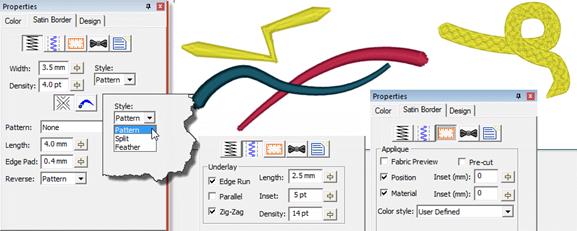 The
satin border is one of the most versatile and easy-to-use stitch types. The
shape is a simply line, with no need to worry about inclinations. The border
follows the outline and has a width, much like a sewing machine. As a satin
stitch, however, there are numerous properties available for the satin
border.
The
satin border is one of the most versatile and easy-to-use stitch types. The
shape is a simply line, with no need to worry about inclinations. The border
follows the outline and has a width, much like a sewing machine. As a satin
stitch, however, there are numerous properties available for the satin
border.

At the top of the property page there are separate buttons to
show the top stitching, underlay and applique properties. The top stitching is
composed of the width and density of the stitch, along with any variation in the
stitch width which gives a simple way for a satin border to approximate a
column, but without inclinations.
The Style of the border topstitch will have a smooth satin or
pattern, a split satin, which divides itself into columns, or a feathered-edge
stitch.
You can also adjust the line and nib style for open path
outlines. The line style varies the width over the length of the outline in a
manner according to the image displayed in the list box.
The nib is the shape of the endpoint. You can use the normal
squared-off satin end, or add a curved or tapered tip to either end for a more
finished look without the use of a column.
The border can have applique steps added to it, very much like
the normal Applique object type, the difference being that when using the satin
border type you have much more control of the topstitch itself.
Please see the Satin Column section for information about the
patterns and underlay.
Tip: When using a wide border, use
a split (value of 2) with no reverse pattern to help prevent the stitches from
looping, while still maintaining the look of a satin.
 The
satin border is one of the most versatile and easy-to-use stitch types. The
shape is a simply line, with no need to worry about inclinations. The border
follows the outline and has a width, much like a sewing machine. As a satin
stitch, however, there are numerous properties available for the satin
border.
The
satin border is one of the most versatile and easy-to-use stitch types. The
shape is a simply line, with no need to worry about inclinations. The border
follows the outline and has a width, much like a sewing machine. As a satin
stitch, however, there are numerous properties available for the satin
border.